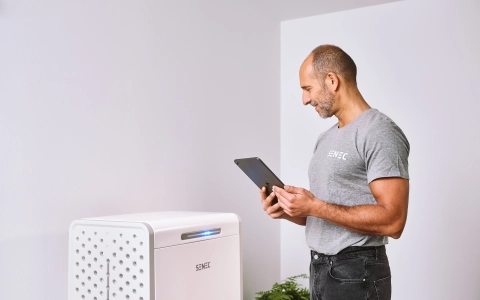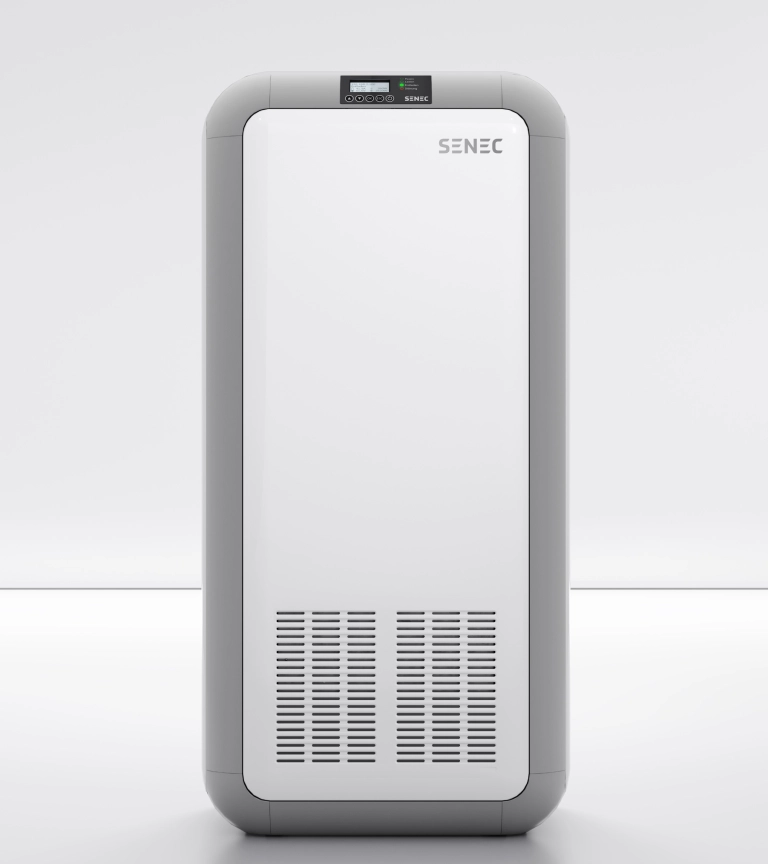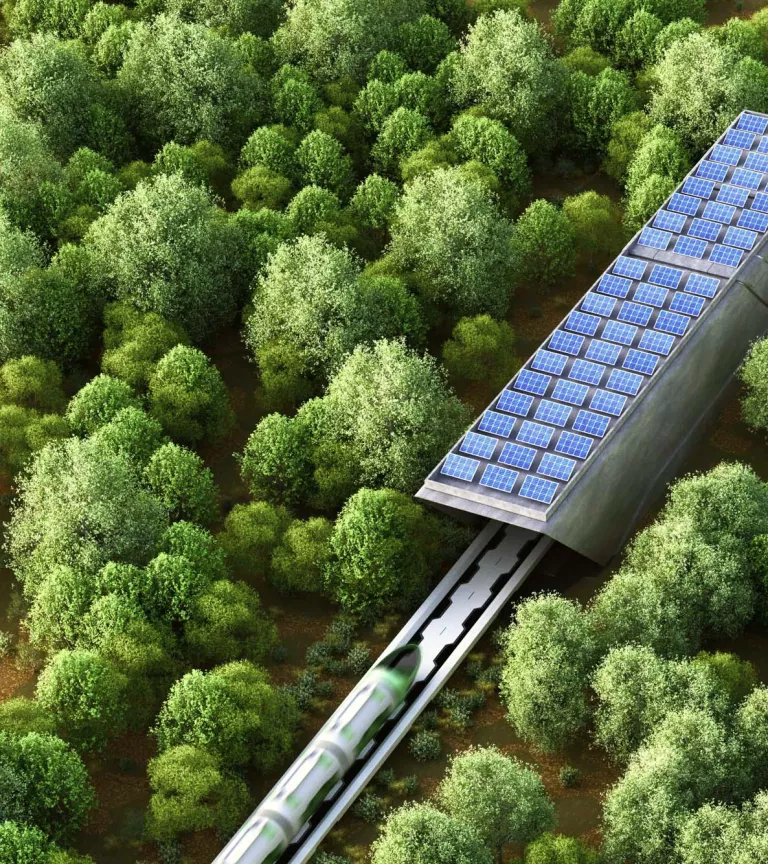
Battery storage systems
Store solar electricity and use it whenever you need
How does a battery storage system work?
In principle, a photovoltaic battery storage system works in the same way as your smartphone’s battery. At its heart is a powerful lithium-ion battery that stores electricity and discharges it when needed. The key difference is that your battery storage system is not charged with electricity from the mains socket but instead with the solar electricity produced by your photovoltaic system. Whenever the solar power system on your roof produces more electricity than is being consumed in your home at that time, the surplus electricity flows into the battery storage device. You can then use this electricity when it’s dark outside or when your PV system is generating less electricity due to adverse weather conditions. This allows you to power your home with self-generated electricity, whatever the weather or time of day.
Would you like to learn more about our PV storage systems?
You can find everything you need to know about SENEC battery storage systems on our product page.
Why is installing a battery storage system worthwhile?
Combining a photovoltaic system and a solar battery storage system enables you become more independent of external power suppliers and reduce your exposure to volatile electricity prices. It helps you to use more of the solar-powered electricity you generate as opposed to feeding it into the public grid at low prices and then buying any additional electricity you need at higher rates. At the same time, you’ll be making your contribution to the energy transition and reducing CO₂ emissions.
Without a PV storage system
At noon, when your solar power system is generating maximum output, you will usually not be able to use all of this electricity right away. You can feed it into the grid – but you will only receive €0.07/kWh if you do. Then, in the morning and evenings when you need electricity, you will have to pay approx. €0.30/kWh to buy electricity from an external supplier. That just doesn’t make sense!
With a PV storage system
This turns the situation on its head: the PV storage device stores the electricity generated over the course of the day so that you can use it whenever you need it. You only sell the electricity you do not need, feeding it into the grid and generating extra income. Say goodbye to electricity bills!
What components make up a battery storage system?
Before you can install a PV battery storage system, you obviously need to have a photovoltaic system on your roof. The battery storage system itself is a compact, floor-mounted system that is connected to your PV system and your home’s distribution box. In addition to the connector cables, a separate circuit breaker for the battery storage system is also installed in the distribution box. Another vital component is an inverter, which converts the direct current generated by your PV system into alternating current so that it can be consumed or stored in your household.
A photovoltaic battery storage system contains:
- Battery (lithium-ion battery)
- Battery management system (BMS)
- Charge regulator
- Battery inverter
- Energy management system (EMS)
- Data visualisation/monitoring system

A battery storage system with integrated inverter
If you already have a solar power system, you probably already have an inverter. Our storage solutions for retrofitting projects, such as the SENEC.Home V2.1, are compatible with most inverters on the market. However, we also offer battery storage systems with integrated inverters, such as the SENEC.Home V3 hybrid, which is an ideal choice for new system installations. This saves the costs of buying an additional inverter and having it installed.

Lithium-ion batteries vs. lead-acid batteries
All SENEC battery storage systems contain powerful lithium-ion batteries. These batteries offer significant advantages compared to the lead-ion batteries in older models of battery storage systems. In a lithium battery storage device, 100% of the storage capacity is available to use – while only 50-60% of a lead battery’s capacity can be used. Lithium-ion batteries are also more efficient, as they have significantly lower energy losses when converting alternating current to direct current. Last but not least, lithium batteries have a much longer service life than lead batteries, which usually need to be replaced after ten years.
Independent power supplies are on trend
Demand for independent power supplies is rising – and with good reason! For one thing, more people are becoming aware of the need for sustainability and systematic climate protection. In addition, consumers are looking to reduce their dependence on energy suppliers and minimise their exposure to volatile electricity prices. New technologies are making battery storage system solutions increasingly affordable. It is also interesting to note that operators of PV systems that feed electricity into the grid are looking for ways to increase their use of self-generated electricity. And, given that retrofitting existing systems with battery storage devices does not usually pose a problem, this too is constantly driving demand.
Who could benefit from a PV storage device?
People who want to reduce their exposure to rising electricity prices
The cost of self-generated solar electricity has been significantly below the price of buying electricity from the public grid for several years now. In fact, the cost of buying electricity from the grid is continuing to rise, with current levels in excess of €0.30 per kilowatt-hour. A battery storage system enables you to use the majority of the electricity you generate. This means you make the most of your self-generated electricity, need to buy less electricity from your energy provider and thereby save money.
People who want to make cost-effective upgrades to their existing PV system
If you already have a solar power system, your feed-in tariff will have a decisive impact on the cost-effectiveness of your installation. Retrofitting your system with a battery storage system is worthwhile as a way to increase your consumption of self-generated electricity, particularly for systems commissioned after 2014. However, even older systems and PV systems that drop out of the guaranteed feed-in tariff system after 20 years can still benefit from having a battery storage system retrofitted.
People who want to invest in sustainable, future-focused energy solutions
The amount of electricity we consume is more likely to rise than fall in the foreseeable future – hence the growing demand for renewable energy solutions. Whether it’s e-mobility, heat pumps to heat your home or air-conditioning systems, many areas of our lives are being permanently electrified. This phenomenon, which is known as sector coupling, makes effective use of energy storage systems more attractive and a key element of the energy transition.
Buying a battery energy storage system: Points to remember
Almost all domestic energy storage systems on the market rely on lithium-ion technology, so the technical differences between them may not be immediately clear. One point worth asking about is storage capacity. In most cases, the storage capacity available for use will be less than the stated nominal capacity. SENEC is the only provide that guarantees 100% of capacity of its storage systems for the first ten years. So, from day one, 10 kilowatt-hours means 10 kilowatt-hours.
Checklist: What can a battery storage system do?
- Monitoring: Is there a function that allows you to see relevant KPIs such as electricity generation, charge level and supply rate?
- Energy management system (EMS): Are there smart functions that enable you to control how the storage system works, e.g. using data from weather forecasts?
- Installation: How much will it cost to install and how much space will the storage system need? Is it a floor-mounted or wall-mounted device?
- Connection to charging point: Can the battery storage system be combined with an EV charging point so that you can charge your car with solar-powered electricity?
- Connection to heat pump: Can you couple the battery storage system to your heat pump to heat your home with solar electricity?
- Smart Home integration: Can the battery storage system be integrated into Smart Home systems?
- Expandable: Does the manufacturer offer additional options and system components to expand your battery energy storage solution as you wish?
Which photovoltaic battery storage system is right for me?
-
 The most flexible system for new installations
The most flexible system for new installationsSENEC.Home V3 hybrid/duo
- Usable storage capacity up to 10 kWh
- Integrated inverter, direct current (DC) and alternating current (AC) connection both possible
-
 Ideal for retrofitting existing systems
Ideal for retrofitting existing systemsSENEC.Home V2.1
- Usable storage capacity up to 10 kWh
- Compatible with existing solar, wind power, cogeneration and hydroelectric generators
Arrange a free consultation
Find the optimal battery storage system solution for your requirements.
The process of installing your PV battery storage system
Mounting and installing your PV battery storage system should take two hours at most. The cable the device requires to transport the solar-powered electricity from the roof into the house will usually have been installed with your PV system. Installing the compact SENEC.Home battery storage system only involves a few additional steps:
- Installation in distribution box: The specialist installing your system will connect the cable and all other necessary accessories to the distribution box.
- Position the battery storage system: The battery storage system is put in position and its battery modules are inserted and connected.
- Start charging: Your installer will start up the storage device and connect it to the SENEC.360 ecosystem, so that you can control it via the SENEC.App.
How long does it take to install a domestic photovoltaic storage system?
First of all, you will make an appointment for your specialist partner to visit your home. They will precisely plan the PV system and the storage device in accordance with your wishes. Following this appointment and a consultation meeting, they will give you a proposal. If you accept it, the process of actually installing a battery storage system is relatively swift.

Award-winning design
Our customers aren’t the only ones who are impressed with our quality and performance: SENEC battery energy storage systems and wallboxes received the Red Dot Award 2022 for their innovative design.
SENEC.Home
SENEC.Wallbox pro
How big should my battery storage system be?
Choosing a storage device with suitable capacity is a decisive factor in the cost effectiveness of your PV system. If the storage device is too small to cover your household’s daily needs, you will have to buy electricity from your energy supplier. If the storage device is too large, it will never be fully charged – and your surplus electricity will always flow into the storage device instead of being fed into the grid. If that happens, you will miss out on the feed-in tariff.
Determining your household’s electricity needs
What size storage device would be suitable for your household is primarily determined by two factors:
- Your electricity usage (annual consumption in kilowatt-hours/kWh)
- The size of your solar power system (capacity in kilowatt-peak/kWp)
The storage device should be able to cover your electricity needs in the evening and at night – i.e. over the period in which your PV system does not generate electricity. As a rule of thumb for a rough calculation, you can estimate that every 1,000 kWh of annual electricity consumption requires around 1 kWp of photovoltaic capacity or 1 kWh of storage capacity.
1,000 kWh annual household consumption = 1 kWp PV = 1 kWh battery capacity
You can roughly establish your annual household electricity consumption by looking at your annual statements for recent years. Your SENEC specialist partner will precisely calculate the size of storage device you need. They will provide detailed advice and recommend a SENEC storage device with storage capacity of either 2.5 kWh, 5 kWh, 7.5 kWh or 10 kWh.
Battery storage system capacity: Three examples
Four-person household
Annual electricity requirement: 4,500–5,000 kWh
PV system: 5-6 kWp
Required storage capacity: 5-6 kWh
Four-person household with a heat pump
Annual electricity requirement: approx. 8,000 kWh
PV system: 8 kWp
Required storage capacity: 8 kWh
Four-person household with a heat pump and EV
Annual electricity requirement: approx. 12,000 kWh
PV system: 12 kWp
Required storage capacity: 12 kWh
How much does a photovoltaic battery storage system cost?
Just like for photovoltaic systems, it not possible to provide a universally applicable figure for how much a battery storage system will cost. The price varies depending on the situation and is based on many different factors. Your personal electricity needs play as much of a role as the size, age and condition of your PV system and your use of other optional accessories, such as a heating element to use solar electricity for your hot water supply. Your SENEC specialist partner will take the time to advise you in detail and calculate the costs for a suitable storage solution.
Smart charging options: Peak shaving and forecast-based charging
Solar power systems generate different amounts of electricity depending on the weather and time of day. Any solar electricity you do not use straight away is stored in your battery storage system or fed into the public grid. However, the German Renewable Energy Act (Erneuerbare-Energien-Gesetz – EEG) and subsidy programmes for battery storage systems set out by different federal states limit the proportion of solar electricity you can feed into the grid. SENEC battery storage systems offer smart management charge functions, giving you the option between peak shaving and forecast-based charging. This enables you to make the most efficient use of your solar-powered electricity and minimise the risk of your PV system being curtailed.
Peak shaving
Excess solar electricity is fed into the grid as a priority. Electricity is only fed into the storage system once the feed-in limit has been reached. Peak shaving processes can be scheduled.
Forecast-based charging
Charging of the storage device is controlled based on weather forecasts and system-specific generation and consumption data. This allows you to use and store as much of your self-generated solar electricity as possible.

Can a photovoltaic storage system provide an emergency power supply?
Blackouts and power cuts are very rare in Germany. However, if a blackout does occur, you could continue to supply power to vital appliances by drawing electricity from your battery storage system. You can determine which appliances are considered vital in your home. For example, you might choose a heat pump or a freezer. The emergency power package is available as an optional add-on.
Arrange a free consultation
Make sure your storage device matches your needs Our experts would be happy to advise you, free of charge.
Do solar battery storage systems come with a warranty?
The warranty for battery storage systems goes far beyond the statutory warranty period of two years. SENEC battery storage systems, for example, come with a ten-year guarantee as standard. You can also take out an extended warranty of 20 years. In addition to the warranty for the device itself, there is a guarantee for the storage capacity – because a battery’s storage capacity decreases over time. Many manufacturers offer a guarantee for 80% of storage capacity. SENEC is the only supplier on the market to offer a 100% storage capacity guarantee for the first ten years.

Checklist for PV battery storage system warranty conditions
How safe are PV battery storage systems?
Safety is a top priority in the production of battery storage systems. A solar storage system is an electrical device, so it comes with certain inherent risks. Stories occasionally appear in the media about fires associated with batteries, which does make some people anxious. However, you should not let such stories worry you. Battery storage systems that contain high-quality battery cells and feature state-of-the-art construction are safe. Experts have confirmed this. After all, there are safety standards in place. If you are having a domestic battery storage system installed, you should make sure that application rule VDE AR-E-2510-50 is observed, as it sets very high safety requirements for the overall system. VDE AR-E-2510-2 describes the safe installation of battery storage systems. You should also ask about the international standard IEC 62619.
Do I need to conclude an electricity contract for my battery storage system?
No, you can continue to purchase additional electricity from your energy provider as before. However, with SENEC.Cloud we give you the opportunity to cover your entire electricity needs with self-generated energy. With our cloud solution, you effectively “pay in” surplus solar electricity over the summer so that you can “withdraw” it over the dark winter months.
Recycling and disposing of battery storage systems
Photovoltaic systems and battery storage systems help to provide a sustainable supply of energy. However, the issue of sustainability doesn’t stop with their disposal. After a long service life, battery storage systems can also be professionally recycled.
Current processes make it possible to recover more than 95% of the nickel, copper and cobalt in batteries, as well as most of the lithium. Demand for lithium-ion batteries is rising, not least in relation to e-mobility. Research institutes and companies around the world are working on new, less energy-intensive means of recovering materials from battery storage systems and the batteries within them.

Old batteries from battery storage systems are returned to their manufacturers
According to the German Battery Act (BattG), manufacturers are obligated to take back and recycle their batteries. As a distributor, SENEC is obligated to take back your old batteries free of charge – just as you can return old household batteries to supermarkets. We return the batteries to the manufacturer, who is best placed to reuse the valuable materials.

